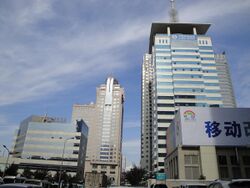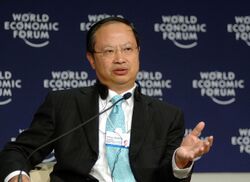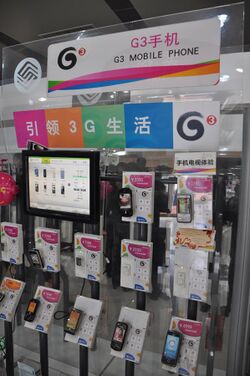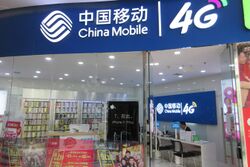China Mobile
Topic: Company
 From HandWiki - Reading time: 10 min
From HandWiki - Reading time: 10 min
 | |||||||
 | |||||||
| Type | Public; state-owned enterprise | ||||||
|---|---|---|---|---|---|---|---|
| |||||||
| ISIN | [https://handwiki.org/wiki/index.php?title=Toollabs:isin/&language=en&isin=HK0941009539 HK0941009539] | ||||||
| Industry | Telecommunications | ||||||
| Predecessor | China Telecom (Hong Kong) Limited[1] | ||||||
| Founded | 3 September 1997[2] | ||||||
| Headquarters | Beijing, China Shanghai, China | ||||||
Area served | |||||||
Key people | Yang Jie (Chairman) Li Yue (CEO)[3] | ||||||
| Services |
| ||||||
| Revenue | |||||||
| Total assets | |||||||
| Total equity | |||||||
| Owner | Government of China (72.72%)[5]:65 | ||||||
Number of employees | 450,698 (2022)[4] | ||||||
| Parent | China Mobile Communications Group | ||||||
| Subsidiaries |
| ||||||
| |||||||
| Website | www www | ||||||
| Footnotes / references Source of the financial figures: the consolidated financial statements[5] | |||||||
| China Mobile Limited |
|---|
China Mobile is the trade name of both China Mobile Limited (Chinese: 中国移动有限公司; pinyin: Zhōngguó Yídòng Yǒu Xiàn Gōngsī) and its ultimate controlling shareholder, China Mobile Communications Group Co., Ltd. (Chinese: 中国移动通信集团有限公司; pinyin: Zhōngguó Yídòng Tōngxìn Jítuán Gōngsī, formerly known as China Mobile Communications Corporation, "CMCC"), a Chinese state-owned[6] company. China Mobile Limited provides mobile voice and multimedia services through its nationwide mobile telecommunications network across mainland China and Hong Kong.[2] China Mobile is the largest wireless carrier in China, with 945.50 million subscribers as of June 2021.[7]
China Mobile Limited is listed on the Hong Kong Stock Exchange.[2] It is the world's largest mobile network operator by total number of subscribers.[8]
(As of October 2020), China Mobile Limited's total market value stood at HK$965 billion, which is the largest red chip company.[9]
History
Incorporated in 1997 as China Telecom (Hong Kong) Limited,[1] China Mobile was born from the 1999 break-up of China Telecommunications Corporation.[10] This company continues to provide mobile services, however.[11]
In May 2008, the company took over China Tietong, a fixed-line telecom[12] and the then third-largest broadband ISP in China[13] adding Internet services to its core business of mobile services.
In October 2014, Nokia and China Mobile signed a $970 million framework deal for delivery between 2014 and 2015.[14]
In December 2021, China Mobile announced that its international arm would cease operations in Canada due to national security concerns by the Canadian government.[15]
U.S. sanctions
In November 2020, President Donald Trump issued an executive order prohibiting any American company or individual from owning shares in companies that the United States Department of Defense has listed as having links to the People's Liberation Army, which included China Mobile.[16][17][18] On 31 December 2020, the New York Stock Exchange announced that it would suspend trading in China Mobile, China Telecom, and China Unicom from 7 to 11 January 2021 and start the delisting process, causing stock values to drop.[19] On 4 January the decision to delist was suddenly reversed; two days later, the NYSE said that the delistings would proceed.[20] In the aftermath of the delisting, the company announced its decision to raise up to US$8.8 billion ahead of the Shanghai stock exchange listing, according to an official Weibo post by the company.[21]
In March 2022, the Federal Communications Commission designated China Mobile's U.S. subsidiary, China Mobile International USA, a national security threat.[22]
Ownership and control
A state-owned enterprise directly controlled by the government of the People's Republic of China[6] and also a public company which is listed on the NYSE and the Hong Kong stock exchanges,[2] China Mobile has dominated Chinese mobile services since its inception for civilian and military purposes. According to the United States Department of Defense, the company has links to the People's Liberation Army.[23] (As of 2010), China Mobile controls the vast majority of its domestic mobile services market with a 70% market share.[11] China Unicom and China Telecom have 20% and 10% shares, respectively.[11]
The company likely enjoys substantial protectionist benefits from China's government[24] but also experiences frequent government intervention in its business affairs.[25] Government control is maintained through a presumably government-owned holding company, China Mobile Communications Group Co., Ltd. (formerly: China Mobile Communications Corporation; CMCC), that owns 100 percent ownership of China Mobile (HK) Group Limited,[26] which in turn holds over seventy percent ownership of China Mobile–the remainder being controlled by public investors.[2] Established in 2000,[26] CMCC is China Mobile Ltd's current parent company (As of 2019).[5]
Services
Rural services

China Mobile was one of six state-owned companies that implemented the Connecting Every Village Project, which the Ministry of Industry and Information Technology began in 2004 to promote universal access to telecommunication and internet services in rural China.[28](pp24-25) The MIIT required that China Mobile and the other state-owned companies build the communications infrastructure and assist in financing the project.[28](p25) As of December 2019, 135 million rural households had used broadband internet.[28](p25) The program successfully extended internet infrastructure throughout rural China and promoted development of the internet.[28](p25)
China Mobile has historically held a greater share of the rural market than competitors.[29] By 2006, its network had expanded to provide reception to 97% of the Chinese population,[30] and the company has since seen a sustained stream of new, rural mobile customers.[29]
It also offers services targeted at the rural market including an agricultural information service, which facilitates a variety of activities such as the sale and purchase of agricultural products, access to market prices for produce and crops, wire transfers, bank withdrawals, and payments, etc.[31]
Overseas activities
The company branched out in 2007 with the purchase of Paktel in Pakistan[32] launching the Zong brand there a year later.[33]
In 2013, China Mobile eyed expansion into Myanmar expressing interest in bidding for one of two licences on offer in a partnership with Vodafone although this plan ultimately fell through.[34]
Brands
Mainland China
Mobile services are available in Mainland China under several brands as of 2007.[35] (As of 2013), the below brands are scheduled to be slowly phased out and replaced by an all-encompassing new brand name—And[36]—whose logo combines an exclamation point, the Chinese character for "peace" (和; Hé), as well as the English word "and".[37]
- GoTone
(Chinese: 全球通; pinyin: Quánqiútōng Rough translation: "Global Connect"): subscription[38] flagship brand[39]
- M-zone
(Chinese: 动感地带; pinyin: Dònggǎndìdài Rough translation: "Dynamic Area"): a premium prepaid service popular with youths[39]
- Easyown
(Chinese: 神州行; pinyin: Shénzhōuxíng Rough translation: "Travel across China"[38] (lit. "travel the holy states")): a basic prepaid mobile phone service more heavily marketed in rural areas[30]
- G3
A 3G service brand using TD-SCDMA[37] (likely introduced post-2007)
- and!和
A 4G/LTE service brand using TD-LTE
Hong Kong
CMHK is a wholly owned subsidiary of China Mobile. It offers GSM, GPRS, EDGE, HSPA+ (MVNO), FD-LTE and TD-LTE technologies to customers in this the Hong Kong Special Administrative Region.[40]
Pakistan
- Zong is China Mobile's brand in Pakistan and is operated by China Mobile Pakistan (CMPak), a subsidiary.[33]
United Kingdom
In December 2017, China Mobile launched a MVNO service in the UK called CMLink. CMLink is aimed at the Chinese population living in the UK and Chinese visitors and students. Plans include free calls to China Mobile phones in China.[41]
Singapore
In June 2020, China Mobile launched a MVNO service called CMLink. It uses Singtel networks, which is one of Singapore's largest mobile network operator.
CMLink is aimed at the Chinese population living in the Singapore and Chinese visitors and students. Plans include free calls to China Mobile phones in China.[41]
Network
China Mobile operates a GSM network,[42] which encompasses all 31 provinces, autonomous regions, and directly administered municipalities in Mainland China and includes Hong Kong, too.[2] GPRS is utilized for data transmission.[43]
- 3G
Marketed as "G3", the company controls 70% of the Chinese mobile market but a far smaller percentage of the 3G market.[11] (As of May 2012), its nearly 60 million 3G subscribers account for roughly 9% of its total subscriber base,[44] which is an increase from 3% in 2010.[11]
Its 3G network, still under construction in 2010, utilizes the TD-SCDMA standard, which China Mobile helped develop. 3G service is available in all of the 4 direct-controlled municipalities and most of the 283 prefecture-level cities in China (As of 2010).[45]
- 4G
Marketed as "and和", as of 2010, China Mobile has debuted small-scale 4G demonstration networks using a variant of 3GPP's Long Term Evolution, TD-LTE, and has plans for larger, citywide demonstration networks in the future.[45] (As of May 2012), such networks are in operation.[44]
While prior iPhone models could not use the China Mobile network due to the chipset relying on WCDMA-based networks, talks to carry the then unreleased 4G iPhone (iPhone 5) began in mid-2012.[44] The iPhone 5c and iPhone 5s were sold through China Mobile starting in January 2014.[46]
- Everest
In 2003 and again in 2007, China Mobile provided mobile services on Mount Everest.[47]
- Spratly Isles coverage
In May 2011, China Mobile announced its network now includes the controversial Spratly Islands.[48]
See also
- List of largest companies by revenue
- List of mobile network operators
- List of mobile network operators of the Americas
- List of mobile network operators of the Asia Pacific region
- List of mobile network operators of the Middle East and Africa
References
- ↑ 1.0 1.1 Milestone China Mobile Official Site
- ↑ 2.0 2.1 2.2 2.3 2.4 2.5 Overview China Mobile Limited Official Site
- ↑ "Board of Directors". China Mobile Limited Official Website. https://www.chinamobileltd.com/en/about/directors.php.
- ↑ 4.0 4.1 4.2 4.3 4.4 4.5 "Annual Report 2022". China Mobile. pp. 19, 22. https://www.chinamobileltd.com/en/ir/reports/ar2022.pdf.
- ↑ 5.0 5.1 5.2 Annual Report 2019 (Report). China Mobile Limited. 2020. https://www.chinamobileltd.com/en/ir/reports/ar2019.pdf. Retrieved 13 November 2020.
- ↑ 6.0 6.1 Strait deals The Economist, 7 May 2009
- ↑ "China Mobile Limited - Investor Relations > Operating Data". https://www.chinamobileltd.com/en/ir/operation_q.php.
- ↑ "The Largest Mobile Network Operators In The World" (in en-US). 2017-04-25. https://www.worldatlas.com/articles/the-largest-mobile-network-operators-in-the-world.html.
- ↑ "List of Red Chip Companies". Hong Kong Exchanges and Clearing. 31 October 2020. https://www.hkex.com.hk/Market-Data/Statistics/Consolidated-Reports/China-Dimension?sc_lang=en&select={55AE8A39-A5A2-4489-95E1-21E30BDEAFD7#select1=0&select2=1.
- ↑ Asian economic and political issues, Volume 8 (page 68) Frank Columbus, Nova Publishers, 2003 (Google Books)
- ↑ 11.0 11.1 11.2 11.3 11.4 China Mobile Still Dominates, but Faces Competition in 3G. morningstar.com, 22 October 2010
- ↑ Telecoms in China The Economist, 29 May 2008
- ↑ China Mobile to take over China Tietong Telecom[yes|permanent dead link|dead link}}]
- ↑ "Nokia, China Mobile sign $970 million framework deal" (Press release). Reuters. 10 October 2014. Archived from the original on 24 September 2015. Retrieved 30 June 2017.
- ↑ "Chinese mobile phone giant pulling out of Canada amid security concerns" (in en). 28 December 2021. https://www.richmond-news.com/local-news/chinese-mobile-phone-giant-pulling-out-of-canada-amid-security-concerns-4905052.
- ↑ Chen, Shawna (November 12, 2020). "Trump bans Americans from investing in 31 companies with links to Chinese military". Axios. https://www.axios.com/china-military-trump-investments-ban-a0458e29-2245-4bde-920b-d1c6bc698370.html.
- ↑ Pamuk, Humeyra; Alper, Alexandra; Ali, Idrees (2020-11-12). "Trump bans U.S. investments in firms linked to Chinese military" (in en). Reuters. https://www.reuters.com/article/us-usa-china-securities-exclusive-idUSKBN27S2X3.
- ↑ Swanson, Ana (2020-11-12). "Trump Bars Investment in Chinese Firms With Military Ties" (in en-US). The New York Times. ISSN 0362-4331. https://www.nytimes.com/2020/11/12/business/economy/trump-china-investment-ban.html.
- ↑ Mozur, Paul (2021-01-01). "New York to Delist Chinese Telecom Firms in Symbolic Shift" (in en-US). The New York Times. ISSN 0362-4331. https://www.nytimes.com/2021/01/01/business/nyse-delist-china-mobile.html.
- ↑ Leo Sun (7 January 2021). "4 Lessons From China Mobile's Delisting Debacle". https://www.nasdaq.com/articles/4-lessons-from-china-mobiles-delisting-debacle-2021-01-07.
- ↑ "China Mobile to raise up to $8.8bn in Shanghai share listing" (in en-GB). BBC News. 2021-12-21. https://www.bbc.com/news/business-59737199.
- ↑ Shepardson, David; Satter, Raphael (2022-03-26). "U.S. FCC adds Russia's Kaspersky, China telecom firms to national security threat list" (in en). Reuters. https://www.reuters.com/business/media-telecom/us-fcc-adds-ao-kaspersky-lab-china-telecom-firms-national-security-threat-list-2022-03-25/.
- ↑ Allen-Ebrahimian, Bethany (June 24, 2020). "Defense Department produces list of Chinese military-linked companies". Axios. https://www.axios.com/defense-department-chinese-military-linked-companies-856b9315-48d2-4aec-b932-97b8f29a4d40.html.
- ↑ Asian Economic and Political Issues, Volume 8 (page 54) 2003. Frank Columbus. Nova Publishers. (Google Books)
- ↑ Asian Economic and Political Issues, Volume 8 (page 84) 2003. Frank Columbus. Nova Publishers. (Google Books)
- ↑ 26.0 26.1 CMCC Profile CMCC Official Site (Archive.org cache)
- ↑ Copyright World Economic Forum
- ↑ 28.0 28.1 28.2 28.3 Shi, Song (2023). China and the Internet: Using New Media for Development and Social Change. New Brunswick, NJ: Rutgers University Press. ISBN 9781978834736.
- ↑ 29.0 29.1 "Chinese Telecom: China Mobile Leads the Way" . Bloomberg BusinessWeek. 5 August 2009
- ↑ 30.0 30.1 Homepage > Brand & Products > Business Review CMCC Official Site
- ↑ 2008 Corporate Social Responsibility Report – Rural Program CMCC Official Site
- ↑ CMCC Officially Enter Pakistani Telecommunication Market, 25 March 2007 CMCC Official Site
- ↑ 33.0 33.1 ZoNG the first international brand of China Mobile being launched in Pakistan, 5 April 2008 CMCC Official Site
- ↑ "Vodafone and China Mobile pull out of Myanmar race". Thomson Reuters. 31 May 2013. https://www.reuters.com/article/us-vodafone-chinamobile-myanmar-idUSBRE94U0FT20130531.
- ↑ "Our Brands". China Mobile. 2007. http://www.10086.cn/en/mainland/products/brands.html. (Archive.org cache)
- ↑ "Leo Burnett Wins Pitch for Telecom Giant China Mobile 'And' Brand". Leo Burnett. 12 January 2016. http://leoburnett.com/articles/news/leo-burnett-wins-pitch-for-telecom-giant-china-mobile-and-brand.
- ↑ 37.0 37.1 Jingting, Shen (18 December 2013). "China Mobile launches new 4G service brand". China Daily. http://www.chinadaily.com.cn/business/2013-12/18/content_17182127.htm.
- ↑ 38.0 38.1 "DIFFERENCE BETWEEN QUANQIUTONG AND SHENZHOUXING". Shanghai. 19 March 2003. http://home.wangjianshuo.com/archives/20030319_difference_between_quanqiutong_and_shenzhouxing.htm. Retrieved 4 January 2012.
- ↑ 39.0 39.1 Homepage > Brand & Products > Our Brands CMCC Official Site (Archive.org cache)
- ↑ "Corporate Overview". http://www.hk.chinamobile.com/en/about_us/profile/.
- ↑ 41.0 41.1 "China Mobile Launches CMLink UK MVNO for Chinese Community". 13 December 2017. https://www.silicon.co.uk/networks/broadband/china-mobile-cmlink-226057.
- ↑ Beijing Olympic Games spur another technological leap forward China Mobile, 18 Aug 2008
- ↑ Networks & Technologies China Mobile
- ↑ 44.0 44.1 44.2 Lee, Chyen Yee (16 May 2012). "China Mobile in talks with Apple for iPhone". reuters.com (Thomson Reuters). https://www.reuters.com/article/us-chinamobile-idUSBRE84F06I20120516.
- ↑ 45.0 45.1 "China Mobile Limited: Annual Report 2010". China Mobile Ltd. 2010. pp. 13–14. http://www.chinamobileltd.com/images/pdf/2011/ar/2010_a_e_full.pdf. Retrieved 18 June 2011.
- ↑ Anthony Ha (22 December 2013). "Apple Announces Deal To Bring iPhones To China Mobile Starting On Jan. 17". AOL. https://techcrunch.com/2013/12/22/apple-china-mobile/?ncid=fb.
- ↑ For 2003 service, see Everest goes online for anniversary Mary Hennock, bbc.co.uk, Wednesday, 23 April 2003, 04:23 GMT 05:23 UK
- For 2007 service, see China tests Mt. Everest cell station NBC News.msn.com, 13 November 2007 8:09:24 PM ET
- ↑ Ian Mansfield, 18 May 2011, China Mobile Expands Coverage to the Spratly Islands , Cellular News
External links
- Business data for China Mobile:
- No URL found. Please specify a URL here or add one to Wikidata.
 |
28 views | Status: cached on July 28 2024 11:32:46
↧ Download this article as ZWI file
 KSF
KSF


